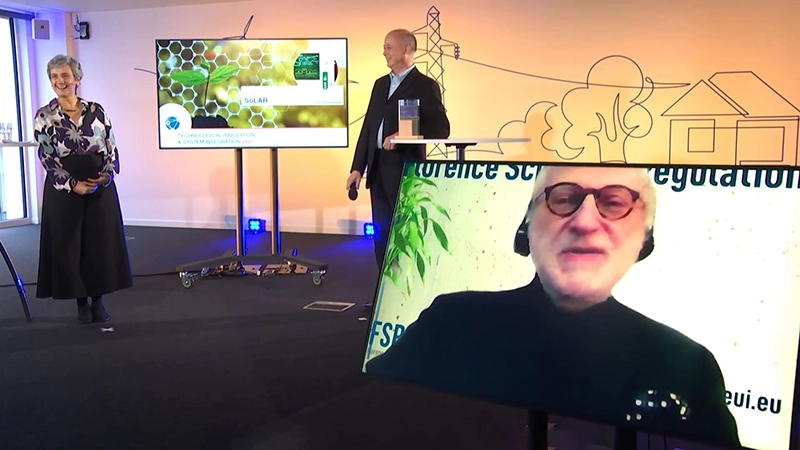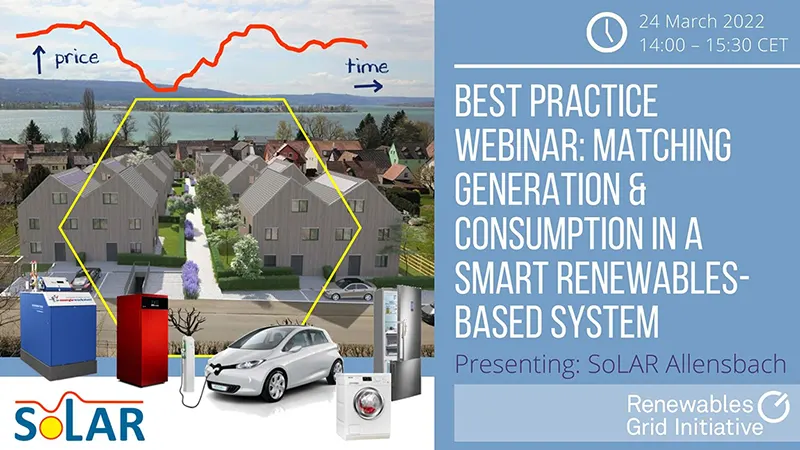Demonstration project „SoLAR“ in Allensbach
Successful energy system transformation
by intelligent energy sector coupling
Stefan Werner, Easy Smart Grid GmbH
Abstract
In the real-world lab project SoLAR in Allensbach (at Lake Constance/Germany) we demonstrate the potential of intelligent energy sector coupling. With a real-time price system on the basis of electric grid state variables, flexible appliances of every type, power and availability can be used as “virtual batteries”. This approach solves the main challenge of energy system transformation: Renewable energy generation profiles that are volatile and do not match conventional consumption profiles. Cost of energy storage and grid extension can be minimized whilst ensuring availability and resilience as well as low complexity of the energy system.
The project has been initiated by citizens engaging in climate protection, and is supported by renowned research institutes and companies. It has been implemented in a new residential development with 22 households in 12 semi-detached houses and two apartment buildings connected with an existing building with three households. It includes smart control of a CHP unit, 12 heat pumps, several household appliances, charging units for electric vehicles and stationary batteries. The objective is to increase CHP and PV electricity self-consumption rate in the residential complex from some 50 to over 80%.
The work done so far shows that the objective can be met. In a next stage demonstration with the city utility of Hassfurt we want to show that the system can be scaled to a whole distribution grid and will be economically feasible. In this context also a new tariff system including dynamic price components will be proposed, providing a generalized approach to intelligent energy sector coupling. This will maximise economic and individual benefits and also aims to respond to existing EU regulatory requirements.
Summary Report
„SoLAR“ (German abbreviation for “Smart Grid without load profile measurement Allensbach-Radolfzell”) has been initiated by the Local Agenda 21 in Allensbach, a citizen climate protection initiative. It is financially supported by the Ministry for the Environment, Climate and Energy Industry of the German State of Baden-Wuerttemberg during the period 2018-21, in the framework of “BWPLUS” funding programme.
Prior to this project, a climate protection guideline had been passed by the community in 2006, stating the objective of climate neutrality by 2050. With funds from the competition “Climate Neutral Communities “, various analyses had been performed since 2010, including a study on coupling the electricity and heating sectors. This showed that 80% of conventional electricity demand can be provided from solar and wind and integrated in the existing energy grid by intelligent coupling with CHP and heat pumps.
In 2016 the Local Agenda developed a concept (“Climate Plan”) to supply the community mainly from renewable energy sources, assuming that all energy sectors (electricity, heating and mobility) will be widely electrified and coupled intelligently. The community also got involved with the SINTEG project C/Sells (a smart grid demonstration project funded by the Federal Government of Germany) where it served as a “participation cell” in its sociological analysis [1], citizen involvement being a major part of this project.
Figure 1 shows estimates of the necessary power of various energy installations in Allensbach required to reduce CO2 emissions by 75% relative to 2002. They assume use of natural gas for CHP and suitable insulation measures for existing buildings.
To make the transformation economically feasible, the plan aims to minimize needs for battery storage and grid extension. This requires intelligent and real time coordination of equipment depending on renewable energy availability. In the project application phase, the patented technology of Easy Smart Grid GmbH (ESG) [2] for decentral energy management was identified as a suitable approach. During the project the technology conceived for micro grids was adapted to the requirements of the European continental grid.

Figure 1: Climate plan of the Local Agenda 21, and climate activities of the Community of Allensbach
Figure 2 shows typical consumption profiles of flexible European household appliances [3] and their adaptation to a typical renewable energy production profile by decentral energy management. Appliance flexibility depends on their available storage capacity, e.g. thermal storage in cooling devices, and customer flexibility, i.e. openness of users to provide a longer time window until dishes are removed from a dish-washer to provide the opportunity to shift the cleaning process in time. The use of such energy flexibility allows to use more renewable energies while respecting typical use constraints.

Figure 2: Typical demand profiles and flexibility potential of household appliances
Changing appliance operating time in the way shown has the identical effect as absorbing surplus generation in a battery, and providing it later to appliances with the normal consumption profile. Intelligent control thus creates low-cost „virtual batteries “. An internal ESG estimate identified 50% of energy consumption in households, business and industry to be able to respond to renewable energy availability and create such virtual batteries.
Energy sector coupling will provide a substantially larger flexibility potential in the future if combined with intelligent control of CHP, heat pumps and EV charging, as illustrated in figure 3 (based on input from [4]). While electricity consumption will grow significantly by sector coupling, it will also provide an estimated flexibility of 80% of future electricity consumption. At the same time the efficiency gains of heat pumps, CHP and electric vehicles limit the additionally required capacity of renewable generation.
Periods without sun or wind are bridged with CHP in the Allensbach concept. Seasonal storage of renewable energy that will become necessary in the future may be achieved by replacing natural gas with hydrogen or synthetically produced methane.
To demonstrate feasibility and economic performance of intelligent energy sector coupling in SoLAR, Kaufmann GmbH/Oberstadion could be won as owner and general contractor of a climate-friendly housing development [5] in Allensbach. Kaufmann has built 12 semi-detached houses and two apartment buildings with a total of 22 households, constructed using mainly wood and insulated according to KfW-40 standard.

Figure 3: High efficiency and flexibility by intelligent energy sector coupling
Figure 4 shows the area and an overview of the most relevant project partners. Scientific partners are the International Solar Energy Research Center (ISC) Konstanz and the European Institute for Energy Research (EIfER) from Karlsruhe. The private electricity grid will be operated by Energiedienst AG in Rheinfelden which takes the roles of metering and energy supplier. Each semi-detached house has its own rooftop-PV and possibly a battery, the apartment buildings have PV installed by Energiedienst. Total installed PV capacity is around 80 kWp.

Figure 4: Demonstration site and project partners
Figure 5 shows a cross-section of the basement with the connecting underground car garage. The 12 semi-detached houses marked in yellow are supplied by individual heat pumps. Heat from ground water is shared by a distribution ring and can also be used for cooling all buildings. The apartment buildings and an existing neighboring building are supplied by a central 21 kWel CHP provided by Energiedienst. All heat generators are intelligently controlled, together with car charging points, household appliances and battery storage in some houses. In total, up to 100 appliances in the area are coordinated, with the objective to increase self-consumption of locally produced electricity from 50 to over 80%.

Figure 5: Basement cross-section of demonstration site
The ESG principle of intelligent appliance control is sketched in figure 6. A price signal is derived from the state of the electric grid, ideally every second. This price signal (balance indicator BI) is normalized between -1 and +1 and indicates energy surplus (low price) or scarcity (high price). Depending on objectives and business model different grid states can be utilized: In isolated grids, energy imbalance can be identified from grid frequency at each location and translated into a BI. In the SoLAR site coupled to the public grid, energy balance can be determined from electric power at the interconnection point at the distribution transformer.
In addition to power balance, information on grid bottlenecks can be derived from voltage at grid connection or current in a grid segment such as the transformer. These can also be translated into price signals (congestion indicator CI) in the range -1 to +1. If several price signals are considered relevant, they can be combined suitably to ensure response by customer devices.

Figure 6: Principle of decentral appliance control by price signals derived from grid states
In the target scenario, the price signal can be constructed in a smart meter from measurements taken (BI generator), or can be received there and forwarded to flexible appliances. The formula to construct the price signal can be provided by a software module encrypted to ensure cyber security.
Controllers of flexible devices decide autonomously to operate preferably during financially attractive periods given their current flexibility, without the need to exchange data with central controls. Return channel communication is ensured by grid reactions to the appliances’ switching decisions.
As only low data rate price signals (~1 Byte/sec) must be received and algorithm implementation can be very lean, this additional functionality can be implemented within existing control units. At the end of the demo project, the suppliers of heat pumps (Weider/Hard in Austria) and CHP (Energiewerkstatt/Hannover in Germany) will directly implement optimized algorithms in their controls.
Within SoLAR the price signal will be used for optimisation of operation only, not for actual billing. Future dynamic tariffs may directly convert price signals into energy prices (BI) or grid fees (CI) by multiplying them with a fixed “flexibility bonus” added to or subtracted from a base price. The necessary values can be stored in a smart meter and exported after a measurement period as averaged or detailed data according to tariff requirement.
Figure 7 and 8 show the effect of the price signal, derived from power balance, on the behaviour of heat generators at the site. For periods of two days, simulations of a “virtual demonstrator” are shown. A digital twin of the site was developed by EIFER that virtually represents it with all appliances at second resolution. During 2021 these simulations will be validated in the real demonstration site.

Figure 7: Reactions of CHP and heat pumps on price signal (BI), summer scenario
At the left-hand side, a regular two-point control maintains the temperature in the hot-water buffer in a given range. At the right-hand side the controller also receives and reacts to a price signal (BI). In summer (only hot water) heat pumps shift operation to times of maximum PV production. They learn attractive activation price ranges. Appliances with only partly filled thermal buffers react first due to their limited flexibility. As operation control occurs in real time, control power can also be provided: If power balance is disturbed e.g. by cloud moving over the PV panels, heat pumps switch off immediately of operating parameters (such as minimum run-time) permit. The CHP plant shifts operation to evening hours with highest energy import and reduces its output such that it can run once every day at highest return (lowest BI, highest price).
As little heat is needed in summer, grid stabilisation effect is visible but small. During winter season operating times are substantially longer, with a much larger grid-supporting effect of intelligent operation. The combined effects of large energy demand by heat pumps and similarly large supply by CHP leads to a more stable “price”. This is equivalent to a smaller and more uniform grid load with a BI close to zero, expressing maximum autarky. Coupling the different heating subsystems thermally would even enlarge this effect.

Figure 8: Reaction of CHP and heat pumps on price signal (BI), winter scenario
Figure 9 shows how SoLAR enables control of devices which could not be integrated with conventional energy management systems that are based on operating schedules and aggregation: While fridges and freezers by principle are flexible, they normally have such a small energy storage capacity and temporal flexibility that they cannot participate in electricity markets. Within a real-time price system, however, they can contribute to grid stability. BSH Hausgeräte GmbH provides a free cooling device to each household within the SoLAR project to validate this effect. The simulation of 48 devices shows how these appliances shift their operation as part of a “swarm” to support system objectives while avoiding unwanted synchronisation effects. They smoothen power balance at the grid connection point: when the CHP switches on (marked in red) they react by maximising power consumption and thus dampen the transient.

Figure 9: Reaction of fridges and freezers on price signal (BI)
Researchers at DFKI (the German Research Centre for Artificial Intelligence) in Bremen have quantitively assessed and visualised the grid stabilisation effect by fridges for SoLAR (figure 10): Short-term power fluctuation is reduced by 10% relative to the moving average. According to BSH, in Germany alone 2.4 GW of such “control power” could be provided by cooling appliances, as compared to a total primary control power of 3 GW in the European grid. With intelligent sector coupling, cooling appliances could thus provide a valuable contribution to primary control (see also [6]).
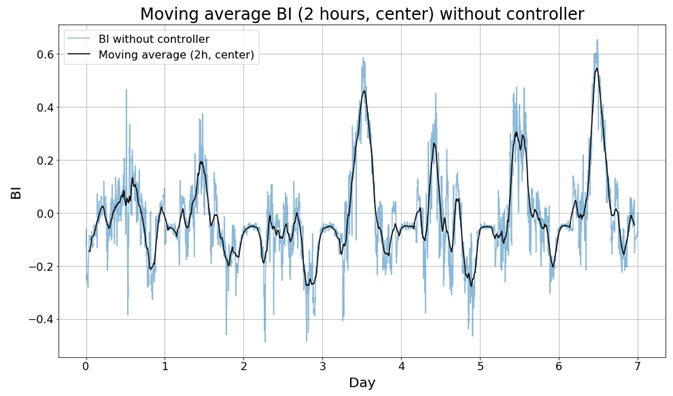

Figure 10: Smoothing of load profile by intelligent control of cooling appliances
The simulation currently is extended to include devices with temporal flexibility without energy buffer, such as electric vehicle charging points, dishwashers, washing machines and dryers. We now also work on implementation controls in the demo site. Figure 11 shows the control concept.
The balance indicator is centrally obtained at the grid connection point of the site, and transmitted to the controls of CHP, EV charging points and appliances in the apartment buildings. For the semi-detached houses the central price signal is combined with one for the individual house in order to maximize self-consumption with electricity generated within that house, and then communicated to the controls of heat pumps and household appliances (this is due to additional privileges for self-consumption within individual households granted by German regulation).

Figure 11: Implementation of control system in demo site
The actual implementation of ICT (information and communication technology) in the demo site by ISC Konstanz is shown in figure 12. Generation of price signal (balance indicator BI) and appliance control (marked “C” for controller) are performed by Kunbus RevPi micro controllers connected via Ethernet, obtaining state variables of relevant grid nodes from smart meter gateways (SMGw). Communication to CHP and heat pumps is achieved via Modbus RTU by serial interfaces. Electric vehicle charging points are connected via Ethernet, and flexible household appliances are interfaced by central servers of HomeConnect (BSH) and Miele@home (Miele) via Internet, respectively. Household appliances are connected to the Internet via Wifi, controllers by cable.

Figure 12: Implementation of ICT for appliance control in SoLAR
ICT implementation in the demo site needs additional controllers, cabling and various interfaces. Appliance connection to the Internet via central servers may be disturbed and has limited access rates such that especially with cooling devices compromises had to be made in the control. Figure 13 therefore suggests how a future ICT system could look for the SoLAR demo site.

Figure 13: Scenario for a future ICT system for intelligent energy sector coupling
Price signals are created directly in smart meters (BI) and communicated via power line (PLC). The necessary data rate of ~1Byte/sec can be implemented at low cost and high reliability without additional cabling and different interfaces. Simple PLC receivers are directly integrated in the appliances and pass the information to their controllers (C) where they are translated into commands. The Internet is used – if at all – for (non-critical) comfort functionality. Any grid operator commands to curtail PV (as prescribed in Germany) are implemented with the same system. Integration with local energy management systems (HEMS) is also possible.
Conclusion
The development and implementation of intelligent energy sector coupling in a virtual demonstrator and a real demo site within SoLAR show that climate neutral energy supply with 100% renewables is possible. The main remaining challenge of energy system transformation – volatile generation from sun and wind cannot follow the load profile of consumers – is solved by maximum use of temporal flexibility in the operation of energy consumers, but also flexible CHP. The extension of intelligent energy sector coupling to seasonal storage e.g. by hydrogen electrolysis needs further analysis.
Integration of the necessary ICT in hard- and firmware of smart meters and appliance controls allows to minimize implementation cost such that flexibility becomes available at very low cost. At the same time the system maximizes system resilience within the framework of a “cellular” approach [7] and offers maximum protection against cyber-attacks and for private data.

Figure 14: Grid system services by intelligent energy sector coupling
A „Plug and Play“ system can be realized by direct use of grid frequency (f) to derive a price signal, or/and creation and communication of price signals from voltage (U), current (I) or power balances via PLC. Central state values can be transmitted from grid operators (!) via their control systems to local distribution stations, and from there via PLC to end customers (see figure 14).
In a next demonstration step the city utility of Hassfurt, an associated partner of SoLAR, will use the technology to maximize self-consumption of renewables in a complete distribution grid. With different actors of the communal energy industry this shall also lead to proposals on the evolution of today’s tariff system to make it future-proof.
Literature
Literature
[1] Smart Grid-Plattform BW. (2021, April 19). Ich bin Zukunft – Allensbach [Online]. Available: https://www.ich-bin-zukunft.de/regionen/allensbach/.
[2] T. Walter, „Verfahren zum Regeln des Verhältnisses zwischen eingespeister und entnommener elektrischer Energie in einem elektrischen Energieversorgungsnetz“, European Patent EP 2 875 560 B1, July 19, 2012.
[3] R. Stamminger, Synergy Potential of Smart Domestic Appliances in Renewable Energy Systems. Bonn: Shaker Publishing, 2009.
[4] V. Quaschning, Sektorkopplung durch die Energiewende. Anforderungen an den Ausbau erneuerbarer Energien zum Erreichen der Pariser Klimaschutzziele unter Berücksichtigung der Sektorkopplung. Hochschule für Technik und Wirtschaft (HTW) Berlin, 2016.
[5] Kaufmann Bau. (2021, April 19). „Wohnen in Allensbach“. [Online]. Available: https://www.wohnen-allensbach.de/.
[6] E. Kremers et al., „Emergent synchronisation properties of a refrigerator demand side management system“, Applied Energy, vol. 101, pp. 709 – 717, 2013.
[7] VDE Verband der Elektrotechnik Elektronik Informationstechnik e.V., Zellulares Energiesystem. Ein Beitrag zur Konkretisierung des zellularen Ansatzes mit Handlungsempfehlungen. Frankfurt am Main: Energietechnische Gesellschaft (ETG), 2019.
RGI Award
The “Renewables Grid Initiative” promotes the international collaboration of grid operators and environmental organisations to stimulate progress towards 100% renewable energy. It regularly identifies the “Good Practice of the Year” in three categories. In 2021, the jury consisting of highly renowned members from industry, research and administrations picked our real-world demo implementation SoLAR Allensbach as the winner in the category “Technological Innovation & System Integration”: Link here
Jean-Michel Glachant, director for energy at the “Florence School of Regulation” and the jury member presenting its judgement, emphasized that “this project puts all the pieces together to create a grid flexibility package in order to meet the challenge of integrating more renewables”. Link here
Find out more about the Renewable Grid Initiative and its award, the submitted projects and the jury: Brochure
Link to Webinar.
You will also find details about our project in our Application for the award.”
Final Workshop
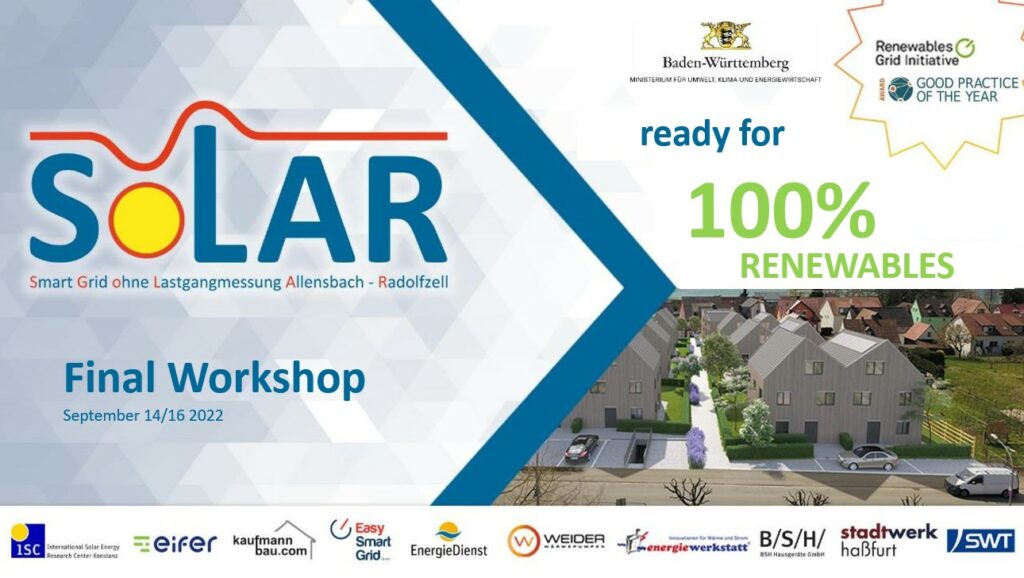
To complete the project presentation, EIFER organized a Final Online Presentation of the SoLAR Project on September 14th 2022. In the event the partners shared the most relevant results after 4 years of demonstration activities both virtually and onsite and allow a space for discussion and idea sharing for possible replication cases. Please find the presented content in the Presentation PDF file.
The online event was followed by a live-visit of the demonstration site of the SoLAR project in Allensbach on September 16th 2022. The on-site presentation was accompanied by a presentation and talks about the application of real-time markets, based on SoLAR, into the energy system to speed up energy transition. The participants had the opportunity to meet the local partners, share experiences and have insights to ongoing activities and follow-ups. Next Steps PDF file.
The Author
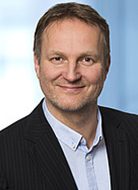
Stefan Werner
Easy Smart Grid GmbH
Solution Manager, Easy Smart Grid GmbH, Karlsruhe
Projekt coordinator „SoLAR“ contracted by ISC Konstanz
Speaker working group „Energy, Ressources, Climate Protection“,
Local Agenda 21, Allensbach

